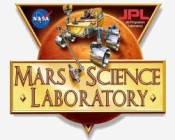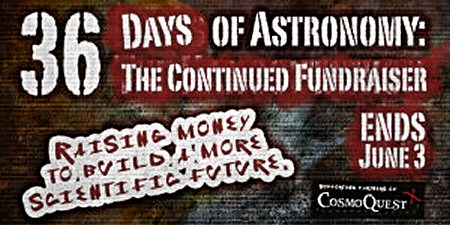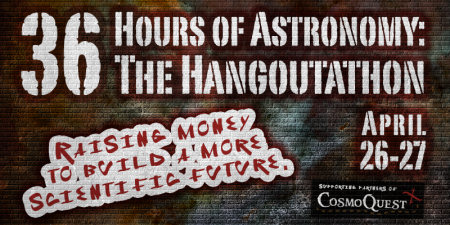The first of six new episodes of The Infinite Monkey Cage, the amazing science comedy radio show from Brian Cox and Robin Ince is now online on the podcast website of the series! And for Music Monday, here’s Eric Idle singing their new title song in best George Formby style, with support from Jeff Lynne on Ukulele and, of course, by Brian and Robin themselves – all in puppet form! :-)
 Last year, the Curiosity Rover celebrated its first Earth year on Mars, but on Monday the Mars Science Laboratory actually completed its first Martian year – has it really been that long already? It feels like it was yesterday when the rover performed a hair-raising landing perfectly, but since then Curiosity has been hard at work learning about the planet, discovering, amongst many other amazing things, without a doubt that there was once flowing water on Mars. The prime mission is now over after 669 Mars days, at least on paper – but the rover is still healthy despite being a little dusty and having some holes in its wheels. Curiosity’s great exploration adventure on Mars will continue together with its smaller relative Opportunity, which has already been on the planet for a decade!
Last year, the Curiosity Rover celebrated its first Earth year on Mars, but on Monday the Mars Science Laboratory actually completed its first Martian year – has it really been that long already? It feels like it was yesterday when the rover performed a hair-raising landing perfectly, but since then Curiosity has been hard at work learning about the planet, discovering, amongst many other amazing things, without a doubt that there was once flowing water on Mars. The prime mission is now over after 669 Mars days, at least on paper – but the rover is still healthy despite being a little dusty and having some holes in its wheels. Curiosity’s great exploration adventure on Mars will continue together with its smaller relative Opportunity, which has already been on the planet for a decade!
Continue reading »
 When the Curiosity Rover arrived on Mars in 2012, I had put together a collection of useful links about the Mars missions, which I still frequently use. The reason for the list was to provide all the information without having to write constantly about the Mars missions myself, something which others are doing in a much better way. I have occasionally written articles about NASA and the Mars missions since then, but even today most of these links are still valid and absolutely essential if you want to keep up with what’s going on on Mars. This is the third edition of the link list, this time a little more compact and streamlined because I removed some non-essential and defunct links.
When the Curiosity Rover arrived on Mars in 2012, I had put together a collection of useful links about the Mars missions, which I still frequently use. The reason for the list was to provide all the information without having to write constantly about the Mars missions myself, something which others are doing in a much better way. I have occasionally written articles about NASA and the Mars missions since then, but even today most of these links are still valid and absolutely essential if you want to keep up with what’s going on on Mars. This is the third edition of the link list, this time a little more compact and streamlined because I removed some non-essential and defunct links.
NASA Websites – The official sources
• Mars Science Laboratory @ JPL – The most important, always up-to-date site
• Mars Science Laboratory Raw Images – Everything the rover cameras deliver
• Mars Science Laboratory @ NASA – NASAs Curiosity website with sometimes different content
• NASA Main Page – Not only Mars news, but still a great resource
• NASA Television – Live stream of the current program
• NASA Television @ Youtube – NTV’s video archive
Other Websites – The inofficial ones often do it much better
• Universe Today – Simply the best resource not only for Mars, but all things space
• Universe Today @ Youtube – All the videos from UT including the hangouts
• Planetary Society Blog – Emily Lakdawalla’s detailed reporting
• Curiosity Rover Images – Better overview of the raw images including an RSS-Feed
• Midnight Planets – Another browser for the raw images of both rovers
• Mars Ogler – Another browser for the raw images
• HiRISE Image Catalog – High resolution images from orbit (also with an RSS-Feed)
Twitter Streams – Because it’s often much faster
• Curiosity-Rover – NASA’s official account of the rover
• Mars Rovers – Spirit and Opportunity’s account
• NASA JPL – Jet Propulsion Laboratory’s account
• Curiosity Log – A drive logbook of the rover
• Universe Today – Announcements from the website
• Emily Lakdawalla – Planetary Society Space Evangelist & Mars Writer
Updates:
27.09.12 » Added HiRISE and Curiosity Raw Images Browser
03.10.12 » Added Mars Ogler
08.08.13 » English version posted, slightly updated & improved
26.06.14 » Cleaned up and improved 2014 version posted
 It’s almost summer and that means there will be new radio shenanigans from Brian Cox and Robin Ince – their brilliant science-comedy radio show The Infinite Monkey Cage will return to the airwaves starting on July 7th via BBC Radio 4 and, as usual, also in the shape of freely available podcasts published on the series’ website in mp3 fomat. There are already 48 past episodes available plus a special from this March called Brian and Robin’s Infinite Inbox in which the duo answers some of the mail the show has been getting!
It’s almost summer and that means there will be new radio shenanigans from Brian Cox and Robin Ince – their brilliant science-comedy radio show The Infinite Monkey Cage will return to the airwaves starting on July 7th via BBC Radio 4 and, as usual, also in the shape of freely available podcasts published on the series’ website in mp3 fomat. There are already 48 past episodes available plus a special from this March called Brian and Robin’s Infinite Inbox in which the duo answers some of the mail the show has been getting!
I can only highly recommend this show – Brian Cox and Robin ince are utterly funny and their guests are always fantastic. Besides, it’s even educational, despite most shows ending up somewhere completely different than they originally started – but that’s just the fun of it. As usual, major English listening skills and a healthy curiosity about science are required, but it’s actually quite easy to listen to. And, of course, if you like Brian Cox and/or Robin Ince, you’re in for a very special treat.(Note: I wrote the last paragraph for the previous post about the series, but why write something new when there’s something perfectly okay available to recycle?)
 Tomorrow evening, a new group of astronauts will be launching into space to the International Space Station from the Baikonur Cosmodrome in Kasachstan. The second part of Expedition 40 will be the American Reid Wiseman, the Russian Maxim Surayev and the German Alexander Gerst – a truly international crew of three countries who may be at odds in the political world, but in space this does not matter at all.
Tomorrow evening, a new group of astronauts will be launching into space to the International Space Station from the Baikonur Cosmodrome in Kasachstan. The second part of Expedition 40 will be the American Reid Wiseman, the Russian Maxim Surayev and the German Alexander Gerst – a truly international crew of three countries who may be at odds in the political world, but in space this does not matter at all.
Tomorrow’s Soyuz launch will be at 21:56 CEST or 7:56pm UTC, with the docking scheduled for 04:14 CEST or 02:14am UTC. There is also going to be a special ESA post-launch hangout with Luca Parmitano from the Columbus control center at 22:30 CEST or 10:30pm UTC!
[Update 28.05.: The launch was a success! The three astronauts are in orbit and now have to catch up with the space station. Hopefully they can take the quick route and dock in six hours!]
[Update 29.05.: And they really did it in under six hours! Here are videos from the liftoff, the docking and the hatch opening and welcome ceremony. Now the real work and science begins!]
The mission of Alexander Gerst is, of course, of special interest to us since he is only the third German astronaut to visit the space station after Hans Schlegel and Thomas Reiter and only the second one on a long-term mission – but he is more an European to me in the same group as all other ESA astronauts. I especially love that Gerst has chosen to call his mission Blue Dot after the famous Voyager image and Carl Sagan’s subsequent description of it. I won’t even begin to write about the details of the mission, because today the ESA has uploaded a wonderful 40-page brochure about it, available in both English and German with a lot of information not only about Gerst, but the whole spaceflight experience to the ISS. It’s very well-written and has a lot of amazing photos and graphics, making it very much worth downloading and reading.
Alexander Gerst is also taking a mouse with him to space – an orange plush one, the mascot of the popular German children’s television show Die Sendung mit der Maus. It’s not the first spaceflight of the Maus – it had been on Mir in 1992 when German Astronaut Klaus-Dietrich Flade had taken it on a short visit and even filmed a segment for the program. Alexander Gerst has already appeared in Sunday’s broadcast, which you can still watch in a recording in the ARD Mediathek (in German of course). During his stay in space, he will be answering questions from children on the Maus Website which will probably get read out in the program – there is no word yet if he will be doing video recordings for them or even a live linkup, but maybe something will happen. I love this especially because Die Sendung mit der Maus was a part of my own childhood – the program originally began in 1971 and is older than me!
While he has an official blog on the ESA website, Alexander Gerst is also very active on Twitter as @Astro_Alex, where he has been constantly reporting about his preparations for his first spaceflight and has been posting a lot of photos recently. He is joined by Reid Wiseman at @Astro_Reid and, as I only found out yesterday, by Maksim Surayev at @MSuraev! The cosmonaut just started tweeting again a short while ago and is only posting in Russian – but this should not be a problem with online translation. [Update 31.05.: I keep finding more Russian astronauts on Twitter – Oleg Artemyev, who arrived on the station in March is also tweeting as @OlegMKS!]
The three astronauts of the prime crew have been actively supported by their backups, who will be going to space in November, Samantha Cristoforetti, Anton Shkaplerov and Terry Wirts with both Cristoforetti and Wirts posting many amazing photos from Baikonur on their Twitter streams @AstroSamantha and @AstroTerry. [Update: Shkaplerov is also on Twitter as @AntonAstrey, although he isn’t very active and mostly retweeting from his crewmates.] Cristoforetti is also still actively writing her Logbook on Google+ about her own preparations for her first spaceflght and two weeks ago she did a great ESA Hangout answering questions from all over the world!
If you want to follow all the astronauts on Twitter, I’m still maintaining and updating my Astronaut Twitter List – if you know of any astronauts or cosmonauts I don’t have in there, please don’t hesitate to tell me! With all the great social media involvement, the next year or so is certainly going to be amazing regarding all things spaceflight.
This year, for a change, I have not forgotten that it’s Towel Day today, the annual celebration of all things Douglas Adams and Hitchhiker’s Guide to the Galaxy. This time around, I managed to throw together a couple of things – head over to DVDLog to read the painstakingly translated review of the 1981 Hitchhiker’s Guide to the Galaxy televisison series, which was actually a lot of fun to revisit and update, because it’s not only a disc review, but partly the history of the Hitchhiker’s Guide itself. I originally wanted to make this a double review together with the 2005 movie, but that has to wait until next week or so because writing the translation took a bit longer than I expected!
Back in March, it seems I missed something great – the cast of the Hitchhiker’s Guide Radio Series had been on tour with a live show, but this spring there was a 75-minute live radio broadcast on BBC4 from the whole gang. And of course it’s now off the iPlayer and I haven’t found a recording of it yet – but hopefully it will materialize somewhere!
Meanwhile I’ve been poking around Youtube and there are some great Douglas Adams treasures out there, which I have put together in a little playlist. There are several great documentaries and even the rare South Bank show which I originally saw in dubbed version somewhen in the early 1990s on German television. You can actually find the television series itself somewhere if you search for it, but I’m not linking to it because the Youtube uploads have a really bad image quality compared to the DVD and, of course, because of copyright reasons. Buy the DVD! It’s not like it still costs 30 bucks like it did twelve years ago.
And there’s something which Douglas Adams would have really liked: ISS Expedition 42 is wishing everybody a happy Towel Day! Samantha Cristoforetti, Terry Wirts and Anton Shklaperov are standing here holding a towel in front of the very Soyuz capsule which will bring Maksim Surayev, Alexander Gerst and Reid Wiseman to the ISS in only three days – they are the backup crew and are currently together with them in Baikonur.
Have I forgotten something? Maybe, but I can just add it later here in a sneaky after-publishing-edit – I already added the previous paragraph shortly before posting. Happy Towel Day everyone! :-)
 Tonight, another mission to the International Space Station comes to an end and a new one with the round number 40 starts when Rick Mastracchio, Koichi Wakata and Mikhail Tyurin return to Earth and temporarily reduce the crew to only three people instead of the usual six. NASA Television will as usual broadcast everything with the undocking happening at 00:15 CEST.
Tonight, another mission to the International Space Station comes to an end and a new one with the round number 40 starts when Rick Mastracchio, Koichi Wakata and Mikhail Tyurin return to Earth and temporarily reduce the crew to only three people instead of the usual six. NASA Television will as usual broadcast everything with the undocking happening at 00:15 CEST.
The astronauts are already strapped in and the hatch to the Soyuz capsule has been closed now for a while. Mastracchio and Wakata have already sent goodbye tweets, but the American astronaut has already promised “post-flight fun” and handed the Twitter baton over to Alexander Gerst and Reid Wiseman, who are already reporting a lot about the preparations for their May 28th launch together with their Roscosmos colleague Maksim Surayev – no Twitter link here, since the Russian astronauts are sadly not doing any social media. Scratch that! I’ve since found out that Surayev does in fact regularly tweet as @Msuraev, but he writes in Russian, which is thanks to online translators not a big problem.
[Update: The astronauts are safely back on earth, everything went as smooth as a bumpy, rattling Soyuz re-entry can be. The NASA TV Youtube Channel has a long video from the landing site operations – the capsule actually landed upright and the astronauts had to be pulled out through the top with the help of a mobile gantry. This hasn’t happened for a long time, usually the capsules land on the side.]
With the departure of Mastraccio and Wakata, there is a sort of social media outage on the ISS at the moment, because the only American astronaut Steven Swanson does not have a Twitter account, but there is at least the official Instagram ISS stream, where occasionally photos from orbit get posted. But that will only last until the next three astronauts go up.
Meanwhile, the future of the ISS seems once again in limbo – originally, the Space Station was supposed to stay at least another decade, but now Russian officials are rattling their sabers and saying that they want to give up the cooperation in 2020. As a rule, I won’t comment on the political reasons, but as this comes not from Roscosmos, but Russian deputy prime minister Dmitry Rogozin, this is nothing more than playing politics with spaceflight and science, which is a really sad and stupid situation.
I’ve been watching the new ISS Earth live stream for over a week, but it seems that only now the mainstream press seems to have really noticed it, although Universe Today and a couple of other space-themed media outlets reported the news around May 1st. There seems to be a little confusion about the cameras – this is not the commercial UrtheCast system, which is still in closed beta, but a separate NASA project called the HDEV or High Definition Earth Viewing Experiment. Four different comercially available HD cameras have been put in a climate controlled, but basically otherwise unshielded housing and installed outside the ISS. One camera is looking forward, one down and two aft. The whole unit does not record anything on the station, but directly downlinks its stream to Earth.
While the stream is publicly available over the UStream website, the main reason for this project is to test how modern video cameras are fairing in space. Some parts of the systems were designed by high school students through the NASA Hunch program and student teams are also responsible for the operation of the cameras. One thing to remember when watching the stream is that it is really an experiment – the cameras are fixed and do not have any zoom or panning capability, but switch their views automatically. Of course, there is nothing to see when the ISS is flying over the night side of the earth because the cameras are not light-sensitive enough, but the sunsets and sunrises can be spectacular like in the screenshot above. The broadcast also sometimes has gaps because the bandwith-intensive video connection does not cover the entire globe – just wait a little when a grey screen is shown until the image comes back.
I recommend having a look at the ISSTracker website or the excellent Orbitron program to find out where the ISS currently is – there is hardly a delay in the broadcast so that the orbit indicator is very accurate and can help predict when the station is on the night side of the planet. The bottom line is simply that the views are absolutely gorgeous and while there has been live streaming from the ISS before, this is the very first time that live video from the space station is available in really good quality. Welcome to the future :-).
 The CosmoQuest 36-hour Hangoutathon is over now, but it has been extended into a 36-day fundraiser marathon, so you can still donate to make citizen science possible. If you want to find out how awesome this whole weekend was, you can either watch all 36 hours back to back on Youtube or if you want to jump to a special segment, I have again prepared an index of the uncut, raw footage to make navigating around a little easier. This is just a preliminary index I made without direct input from the CosmoQuest folks, but I know they are going to appreciate it and I hope it will get even more people interested in these amazing citizen science projects. So go watch the science, the astronomy, the fun and the crazyness of 36 hours non-stop fundraising!
The CosmoQuest 36-hour Hangoutathon is over now, but it has been extended into a 36-day fundraiser marathon, so you can still donate to make citizen science possible. If you want to find out how awesome this whole weekend was, you can either watch all 36 hours back to back on Youtube or if you want to jump to a special segment, I have again prepared an index of the uncut, raw footage to make navigating around a little easier. This is just a preliminary index I made without direct input from the CosmoQuest folks, but I know they are going to appreciate it and I hope it will get even more people interested in these amazing citizen science projects. So go watch the science, the astronomy, the fun and the crazyness of 36 hours non-stop fundraising!
Continue reading »
 It’s less than 24 hours until the 2014 CosmoQuest Hangoutathon begins! Are you ready? Have you already donated or do you want to? It’s starting on 5pm CEST or 11am EDT on Saturday! Click on the image to go to the event page where all the information, schedule and video links will appear and also keep an eye on the CosmoQuest page on Google+, the CosmoQuest main website and their Twitter stream, where right now an hourly tweetdown to the Hangoutathon is happening!
It’s less than 24 hours until the 2014 CosmoQuest Hangoutathon begins! Are you ready? Have you already donated or do you want to? It’s starting on 5pm CEST or 11am EDT on Saturday! Click on the image to go to the event page where all the information, schedule and video links will appear and also keep an eye on the CosmoQuest page on Google+, the CosmoQuest main website and their Twitter stream, where right now an hourly tweetdown to the Hangoutathon is happening!
This just came in as I was finishing the article: Pamela Gay has recorded a short introduction about the preparations for the Hangoutathon and maybe there will be a timelapse of her attic being turned into a film studio later!
• The schedule of the Hangoutathon is available here now!
• Another video message from Pamela Gay from this morning.
Update from Sunday: The Hangoutathon is now in hour 23 and the donations are at over $17.000 – that is only $3000 away from last years end result! It’s been absolutely fascinating with lots of fun and interesting guests! It’ll be going on until 5am CEST, which means I sadly won’t be able to see the finale live, but I’ll be writing something tomorrow about it.
Update from Monday: Over $24.000 have been donated until the the end of the Hangoutathon, which is absolutely amazing! While this was still short of the $36k goal, I think it is still a rousing success for CosmoQuest and shows that there are a lot of people out there who genuinely care about the future of science and education. The show – and that’s what it really was – has been utterly amazing and it was pure joy to see the CosmoQuest folks and their friends and collaborators put on such a great effort to ensure that their project is going to survive. And they will make it! You can watch the whole Hangoutathon in this (unofficial) playlist and I’m going to make a complete index again over the course of this week. Go watch if you haven’t already and you can still donate, because the 36-hour hangoutathon has been extended into a 36-day fundraising effort!
Update from Wednesday: The Hangoutathon Youtube Index is now ready!
I’m probably going to update this article later today and tomorrow when more details are coming. For now, here are a couple of links until the Hangoutathon begins:
• The official Youtube playlist of the 2013 Hangoutathon, split by topic
• My previous blog post with the preliminary index of the 2013 Hangoutathon
• Pamela Gay’s April 2013 post about the funding situation at CosmoQuest
• Another blog post from me about CosmoQuest’s Moon- Planet- and Asteroid-Mappers
• A collection of science & astronomy hangouts and podcasts from CosmoQuest and others
• The Journey to CosmoQuest – my 2013 article on how I found CosmoQuest and more
• Follow CosmoQuest on Google+, Twitter and Facebook!
And I will close this post with a variation of what I wrote last year: While the Hangoutathon is not a pay-per-view event and watching is free, the whole reason for this amazing event is to raise money for CosmoQuest. So if you like what they are doing and care about science and astronomy education not only in the USA but worldwide, please consider making a donation – I’m sure that even small amounts are going to help. I will unfortunately not be able to contribute money this year, but if you are in the same situation, you can always help to spread the word and, of course, do Citizen Science yourself!

